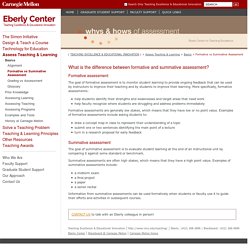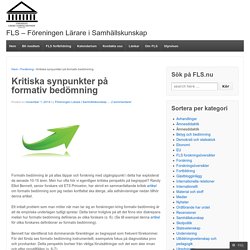

What Are Formative Assessments and Why Should We Use Them? "Informative assessment isn't an end in itself, but the beginning of better instruction.

" —Carol Ann Tomlinson Traditionally, we have used assessments to measure how much our students have learned up to a particular point in time. This is called "assessment of learning" — or what we use to see whether our students are meeting standards set by the state, the district, or the classroom teacher. These summative assessments are conducted after a unit or certain time period to determine how much learning has taken place.
Although assessments of learning are important if we are to ascribe grades to students and provide accountability, teachers should also focus more on assessment for learning. Since formative assessments are considered part of the learning, they need not be graded as summative assessments (end-of-unit exams or quarterlies, for example) are. When I work with teachers during staff development, they often tell me they don't have time to assess students along the way. Exit Cards. Examples of Formative Assessment. When incorporated into classroom practice, the formative assessment process provides information needed to adjust teaching and learning while they are still happening.

The process serves as practice for the student and a check for understanding during the learning process. The formative assessment process guides teachers in making decisions about future instruction. Here are a few examples that may be used in the classroom during the formative assessment process to collect evidence of student learning. Observations Questioning Discussion Exit/Admit Slips. Formative vs Summative Assessment. Formative assessment The goal of formative assessment is to monitor student learning to provide ongoing feedback that can be used by instructors to improve their teaching and by students to improve their learning.

More specifically, formative assessments: help students identify their strengths and weaknesses and target areas that need workhelp faculty recognize where students are struggling and address problems immediately Formative assessments are generally low stakes, which means that they have low or no point value. Examples of formative assessments include asking students to: draw a concept map in class to represent their understanding of a topicsubmit one or two sentences identifying the main point of a lectureturn in a research proposal for early feedback Summative assessment The goal of summative assessment is to evaluate student learning at the end of an instructional unit by comparing it against some standard or benchmark. a midterm exama final projecta papera senior recital.
The Key Differences Between Summative And Formative Assessments. It’s not a stretch to say that assessment is a hot button issue in education; however, you’d be hard pressed to find an educator who doesn’t see the value in measuring student progress. Assessments themselves have been vilified, when, in fact, it’s why assessments are given and how the data is used that is really the issue.
The Glossary of Education Reform gives this great overview of what high-stakes testing is and how it impacts students, teachers, and schools. Basically, high-stakes testing has consequences for the test-takers and givers—sometimes in the form of a high school diploma, grade advancement, and even teachers’ salaries. But not all assessment is high-stakes, and when done thoughtfully, the right assessment can provide extremely useful information for all stakeholders—students, teachers, parents, schools, and policy-makers Let’s take a look at what assessment is, why it’s important, and how it can be delivered in the classroom in a useful manner. Kritiska synpunkter på formativ bedömning. Formativ bedömning är på allas läppar och forskning med utgångspunkt i detta har exploderat de senaste 10-15 åren.

Men hur ofta hör vi egentligen kritiska perspektiv på begreppet? Randy Elliot Bennett, senior forskare vid ETS Princeton, har skrivit en sammanfattande kritisk artikel om formativ bedömning som jag nedan kortfattat ska återge, alla sidhänvisningar nedan tillhör denna artikel. Ett initialt problem som man möter när man tar sig an forskningen kring formativ bedömning är att de empiriska underlagen tydligt spretar.
Detta beror troligtvis på att det finns stor diskrepans mellan hur formativ bedömning definieras av olika forskare (s. 6). (Se till exempel denna artikel för olika forskares definitioner av formativ bedömning). Bennett har identifierat två dominerande förenklingar av begreppet som frekvent förekommer. "Förstärk formativ bedömning med digitala verktyg"